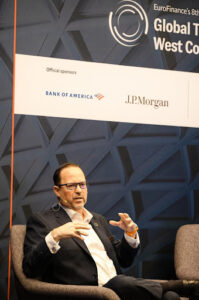Distributed ledger technology (DLT) and digital assets: A corporate treasury perspective

Distributed ledger technology and digital asset applications are gaining attention in the treasury world as corporate treasurers continue to explore use cases to improve the effectiveness of their treasury management activities.
The exploration of distributed ledger technology and digital assets has become an increasingly significant topic in corporate treasury discussions. A recent panel discussion at EuroFinance’s 9th annual Global Treasury Americas West Coast, featuring Todd Yoder, Global MD, strategic finance and treasury at Fluor Corporation, offered deep insights into these areas, providing valuable insight on how distributed ledger technology may shape the corporate treasury landscape.
Embracing DLT and digital assets
From the outset, the discourse emphasized the importance of awareness and comprehension of these emerging technologies. As Yoder astutely cautioned, complacency in understanding these developments could lead to missed opportunities. “The landscape of applications utilizing distributed ledger technology (“DLT”) is growing exponentially and providing the opportunity for corporate finance professionals to add significant value to the business collaborating across finance, supply chain, and operations,” said Yoder. Yoder explained that blockchain is one type of DLT, but other types of DLT are also showing strong use cases in a myriad of applications, such DLT examples include Directed Acyclic Graph (“DAG”), Hashgraph, and Hyperledger Fabric.
Yoder went on to describe the differences between the thousands of crypto coins and crypto tokens, Bitcoin, and the implications of centralized, decentralized, and distributed systems. Yoder mentioned another important factor when considering holding digital assets is how you plan to store digital assets and recommended looking at the pros and cons of custodial services, exchange wallets, digital wallets, cold storage, and decentralized storage.
Exploring the potential applications of DLT beyond digital assets
Yoder delved into the transformative potential of distributed ledger technology (DLT) beyond the realm of digital assets, shedding light on its potential impact on various facets of the corporate treasury landscape. “Distributed ledger technology (DLT) has the power to disrupt not only financial services but also supply chain management, identity verification, governance, audit processes, and the energy sector,” he states.
One promising application of DLT lies in smart contracts. Leveraging the decentralized nature of DLT, self-executing contracts can be built, automating, and enhancing numerous business finance processes related to tax and financial regulations, while significantly reducing counterparty risk, and settlement risk, as elucidated by Yoder.
Another substantial point of the discussion was the integration of DLT into Know Your Customer (KYC) processes. The unique properties of transparency, security, and immutability offered by this technology make it an ideal platform for storing and accessing verified customer data. Implementing DLT in KYC procedures holds immense potential to further streamline the process, resulting in cost and time savings, as well as mitigating the risks of errors and fraud.

Refocusing on the technological advancements and data-driven treasury landscape
Yoder emphasized the importance of considering both the near side, which refers to the user interface, and the far side, being the underlying microservices and infrastructure that supports the user interface. He noted that the future will bring a comprehensive corporate finance superapp that seamlessly consolidates numerous treasury functions into a single easy-to-use and highly secure platform. To achieve this, it is crucial to have a robust far-side infrastructure that supports essential elements such as strong data visualization, top-notch security measures, transparency, traceability, high visibility, and real-time functionality. Although this may seem like a significant undertaking, Yoder reassured that the required technology already exists to build the corporate finance superapp.
Preparing for a DLT treasury landscape
Despite the benefits that distributed ledger technology (DLT) offers to corporate finance, tangible real-world applications for day-to-day cross-discipline activities remain somewhat limited. However, the situation is changing, with an increasing number of solutions progressing from conceptualization to market implementation. Yoder provided an example of a charity considering accepting Bitcoin donations, illustrating how organizations may need to navigate digital assets in the future sooner than they realize. Additional use cases mentioned were associated with repatriating trapped cash, businesses may explore digital assets as an alternative means to repatriate cash and optimize global working capital more effectively. This may entail dealing with new asset forms and technologies, necessitating innovative strategies and management systems.
Furthermore, the discussion also touched on stablecoins, and the nearly 100 central bank digital currency (CBDC) projects in development with 10 to 15 of those currently live. Treasurers’ financial partners have begun to utilize distributed ledger technology (DLT) for more efficient business transactions which could provide significant advantages for corporate finance operations. Streamlining payments and reducing transaction costs and risks are just some of the potential benefits that these technologies offer, underlining the importance for treasury professionals to keep abreast of such developments. Yoder emphasized the importance of corporate treasurers practicing servant leadership and ensuring they are enabling a “learn it all” culture, as continuous learning and investment in education and technology are crucial in the rapidly evolving digital age. “If you aren’t learning, you are on a path to losing,” said Yoder.
In summary, Yoder underscores the growing relevance of distributed ledger technology (DLT) and digital assets in the corporate finance landscape. While the full impact of these technologies is yet to be fully realized, their potential to shape the future is undeniable. Finance professionals should collaborate closely with banks, consultants, auditors, fintech partners, and colleagues to enhance their readiness for a future where these technologies play an increasingly central role in value creation within their organizations.
The world’s largest and most influential treasury event will return this September in Barcelona. Join more than 2000 senior-level professionals representing over from more than 50 countries to exchange experiences, learn best practices and meet best-in-class financial and technological partners. This year we will explore the theme “Navigating a new world,” empowering treasurers to manage today’s new and complex challenges and optimise treasury for the new economic cycle. Find out more.
